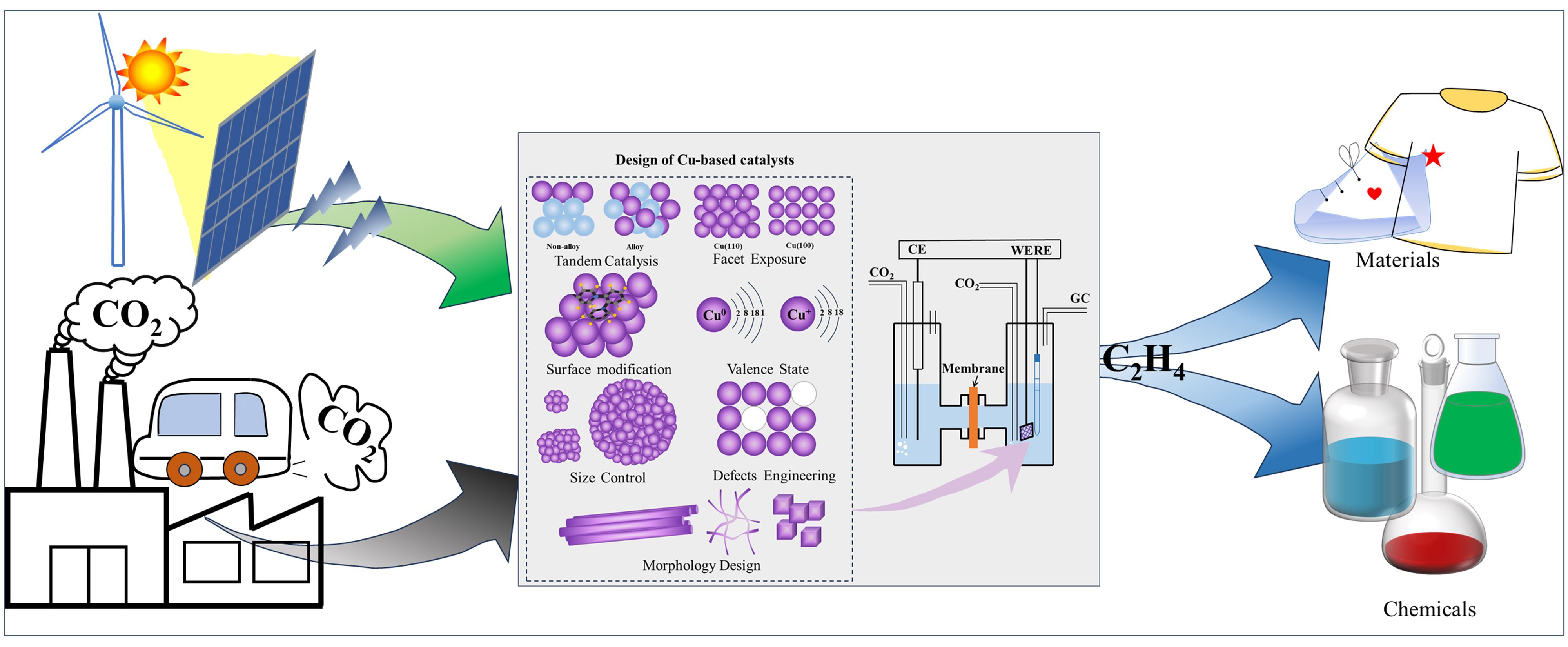Abbreviation (ISO4): Prog Chem
Editor in chief: Jincai ZHAO


Copper Catalytic System for CO2 Electrocatalytic Preparation of Ethylene
Yaqing Hu, Kunyu Xu, Haoling Yang, Fengfan Zhang, Zihao Yang, Zhaoxia Dong
Prog Chem ›› 2025, Vol. 37 ›› Issue (3) : 332-350.
Copper Catalytic System for CO2 Electrocatalytic Preparation of Ethylene
Taking into account environmental concerns and the ongoing shift towards clean energy, converting carbon dioxide (CO2) into ethylene (C2H4) through electrochemical CO2 reduction (ECO2RR) using renewable electricity is a sustainable and eco-friendly solution for achieving carbon neutrality while also providing economic benefits. Despite significant advancements in the field, issues such as low selectivity, activity and stability continue to persist. This paper presents a review of recent research progress in copper-based catalytic systems for ECO2RR in the production of ethylene. Firstly, the mechanism of ECO2RR is briefly summarized. It then highlights various catalyst design strategies for ethylene production, such as tandem catalysis, crystal surface modulation, surface modification, valence influence, size sizing, defect engineering, and morphology design. Finally, the paper discusses future challenges and prospects for the synthesis of ethylene through electrocatalytic CO2 reduction.
1 Introduction
2 CO2 electroreduction mechanisms on Cu catalysts
2.1 The adsorption and activation of CO2
2.2 The formation of *CO intermediates
2.3 C-C coupling
3 Key performance parameter
4 Catalyst design strategies
4.1 Tandem catalysis
4.2 Facet exposure
4.3 Surface modification
4.4 Valence state
4.5 Size control
4.6 Defects engineering
4.7 Morphology design
5 Conclusion and prospect

ECO2RR / ethylene / reaction mechanism / catalysts / design strategy
| [1] |
|
| [2] |
|
| [3] |
|
| [4] |
|
| [5] |
|
| [6] |
|
| [7] |
|
| [8] |
|
| [9] |
|
| [10] |
|
| [11] |
|
| [12] |
|
| [13] |
|
| [14] |
|
| [15] |
|
| [16] |
|
| [17] |
|
| [18] |
|
| [19] |
|
| [20] |
|
| [21] |
|
| [22] |
|
| [23] |
|
| [24] |
|
| [25] |
|
| [26] |
|
| [27] |
|
| [28] |
|
| [29] |
|
| [30] |
|
| [31] |
|
| [32] |
|
| [33] |
|
| [34] |
|
| [35] |
|
| [36] |
|
| [37] |
|
| [38] |
(马一宁, 施润, 张铁锐. 化学学报, 2021, 79: 369.).
|
| [39] |
|
| [40] |
|
| [41] |
|
| [42] |
|
| [43] |
|
| [44] |
|
| [45] |
|
| [46] |
|
| [47] |
|
| [48] |
|
| [49] |
|
| [50] |
|
| [51] |
|
| [52] |
|
| [53] |
|
| [54] |
|
| [55] |
|
| [56] |
|
| [57] |
|
| [58] |
|
| [59] |
|
| [60] |
|
| [61] |
|
| [62] |
|
| [63] |
|
| [64] |
|
| [65] |
|
| [66] |
|
| [67] |
|
| [68] |
|
| [69] |
|
| [70] |
|
| [71] |
|
| [72] |
|
| [73] |
|
| [74] |
|
| [75] |
|
| [76] |
|
| [77] |
|
| [78] |
|
| [79] |
|
| [80] |
|
| [81] |
|
| [82] |
|
| [83] |
|
| [84] |
|
| [85] |
|
| [86] |
|
| [87] |
|
| [88] |
|
| [89] |
|
| [90] |
|
| [91] |
|
| [92] |
|
| [93] |
|
| [94] |
|
| [95] |
|
| [96] |
|
| [97] |
|
| [98] |
|
| [99] |
|
| [100] |
|
| [101] |
|
| [102] |
|
| [103] |
|
| [104] |
|
| [105] |
|
| [106] |
|
| [107] |
|
| [108] |
|
| [109] |
|
| [110] |
|
| [111] |
|
| [112] |
|
| [113] |
|
| [114] |
|
| [115] |
|
| [116] |
|
| [117] |
|
| [118] |
|
| [119] |
|
| [120] |
|
| [121] |
|
| [122] |
|
| [123] |
|
| [124] |
|
| [125] |
|
| [126] |
|
| [127] |
|
| [128] |
|
| [129] |
|
| [130] |
|
| [131] |
|
| [132] |
|
| [133] |
|
| [134] |
|
| [135] |
|
| [136] |
|
| [137] |
|
| [138] |
|
| [139] |
|
| [140] |
|
| [141] |
|
| [142] |
|
| [143] |
|
| [144] |
|
| [145] |
|
| [146] |
|
| [147] |
|
| [148] |
|
| [149] |
|
| [150] |
|
| [151] |
|
| [152] |
|
| [153] |
|
| [154] |
|
| [155] |
|
| [156] |
|
| [157] |
|
| [158] |
|
| [159] |
|
| [160] |
|
| [161] |
|
| [162] |
|
| [163] |
|
| [164] |
|
| [165] |
|
| [166] |
|
/
| 〈 |
|
〉 |